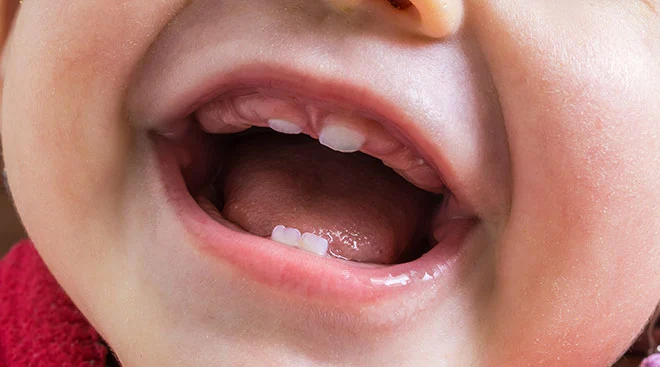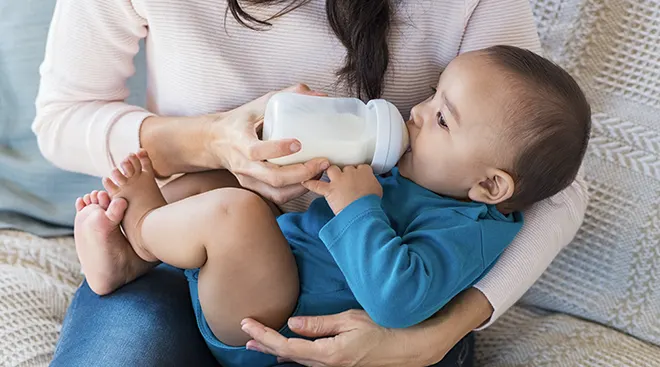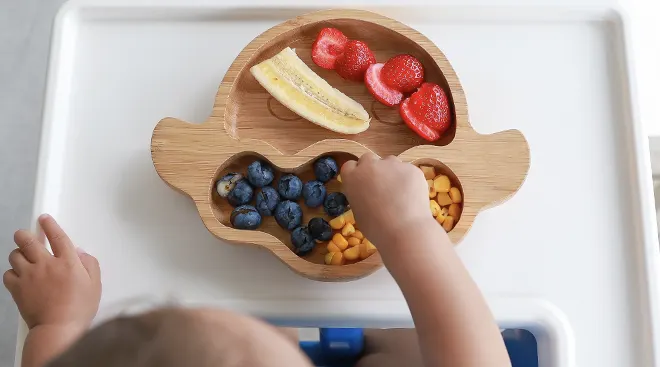What You Need to Know About Lip Ties in Babies and Toddlers
As a new parent, you’ll obsess over every inch of your newborn. You’ll inspect their itty-bitty fingers and toes and wonder (okay, worry!) if that umbilical cord stump is healing properly. You might regularly check their scalp for cradle cap and compulsively apply ointment to that cute little bum at every diaper change. Ready for yet another body part to analyze? Baby’s frenulum. (We’ll save you the trouble of Googling.) When the small stretch of tissue that connects baby’s top gums to their upper lip is too thick or restrictive, there’s concern about a possible lip tie; its presence may limit baby’s oral mobility and potentially lead to feeding challenges.
If your little one is having trouble latching and you can’t quite figure out why, a lip tie could be a contributing factor. But exactly what is a lip tie, and how can you tell if baby has one? Here’s everything you need to know about a lip tie in newborns, infants and toddlers—including symptoms, complications and treatment options.
If you take a quick peek into baby’s mouth, you’ll see a piece of tissue that extends from the gums above their top teeth to the upper lip. This is called a frenulum. A lip tie occurs when the upper frenulum is too tight or thick; this can cause decreased mobility for baby’s upper lip, says Katie Clark, a certified lactation educator and breastfeeding specialist at The Breastfeeding Mama, a virtual support platform for breastfeeding parents.
A baby with a lip tie may experience more challenges breastfeeding than a baby without a pronounced or restrictive upper lip frenulum. And baby’s struggle may also create a painful nursing experience for you. Suffice it to say that if you’re having trouble getting into the groove of breastfeeding and experience pain while nursing for more than a week after birth, it might be a good idea to check baby’s mouth for signs of an upper lip tie and tongue tie.
What does a lip tie look like?
It can be hard to distinguish between a lip tie vs. normal upper frenulum. But if you notice that the tissue looks particularly thick or that it restricts the flexibility of the upper lip, it might indicate a potential issue. Of course, medical experts are trained to identify lip ties and will be able to assess.
Lip tie symptoms can be a bit ambiguous, and the truth is that many of these signs are common among newborns just beginning to nurse. Still, if they’re having trouble getting a good latch, making a clicking noise while nursing or not gaining weight as expected, an upper lip tie might be to blame, says Clark. Excessive gassiness after feedings might be another tip off, says Jin Lin, DMD, a board-certified pediatric dentist and the owner of Hurst Pediatric Dentistry.
Ultimately, baby will need to be evaluated by a pediatrician or dentist to receive a diagnosis. In the meantime, if you’d like to take a peek yourself, gently pull baby’s upper lip away from their teeth and examine under the lip. If lip movement seems restricted, or if the flap of skin that runs from above their front teeth to the underside of the lip looks thick, it could be a lip tie. It’s important to note that all babies (and people, for that matter) have an upper frenulum. It’s only problematic when the frenulum is particularly pronounced and reduces the flexibility of the upper lip.
“Many parents hear about lip ties and see this tissue and start to worry. But it’s more complicated than just seeing the presence, which is why you can’t diagnose it from a picture,” says Clark. In other words, don’t turn to internet images for a diagnosis; instead, consult a medical professional.
When baby’s frenulum is particularly pronounced or tighter than it should be, it can cause complications beyond breastfeeding. Here are the potential issues that affect baby at each age and stage:
Lip tie problems in infancy
With a newborn or infant lip tie, the biggest issue to be concerned about centers around breastfeeding. When a baby can’t latch or feed properly, they may experience slow weight gain, says Clark. What’s more, inadequate emptying of the breast can affect your comfort level, reduce the amount of milk transferred and eventually limit your supply.
Another concern with an infant lip tie is the fussiness and gassiness that happens as a result of an improper latch. Lin explains that baby needs to flange or curl their lips to create a proper seal and adequate suction while breastfeeding. But if the mobility of their upper lip is restricted, they may not be able to curl the lip outward in an efficient way; without that tight seal, air gets into baby’s tummy—and this can cause gas and discomfort. This may be an issue with bottle-feeding as well; if a lip tie impedes baby’s ability to get a good latch on a bottle’s nipple, they may swallow excessive air and experience gas.
Lip tie problems in toddlerhood
A lip tie in baby is a bigger concern, because—if they’re nursed—they rely exclusively on the breast for their nutritional needs. So if you’ve managed to get through the newborn stage, you may be in the clear. Lip ties in older babies and toddlers are typically less troublesome. Still, the American Speech-Language-Hearing Association notes that a significant lip tie may cause challenges with spoon-feeding and, later, with finger foods; these difficulties could cause frustration and ultimately lead to picky-eating habits. What’s more, if milk or food is getting trapped under a tight frenulum, it could eventually lead to cavities in your little one’s two front teeth.
Lip tie problems later in life
The good news is that lip tie problems later in life are relatively rare. Again, cavities in the front teeth could be a concern, so take extra precautions and rinse and brush regularly.
You may wonder if a lip tie can cause speech issues in kids, but there actually isn’t much research that definitively connects the two. However, speech problems have been found to be more common among kids that have both a tongue tie and a lip tie.
Since breastfeeding presents several significant challenges for a baby with a lip tie, some parents may opt to bottle-feed with pumped breast milk or formula.
If baby has a lip tie and you want to continue breastfeeding, there are a few things you may be able to do in order to boost your chances of success. First, Clark recommends trying to avoid feeding when your breasts are very full. “When a mom is experiencing engorgement, it makes the breast more tight, which can make it harder for baby to latch on.” You’ll want to take steps to relieve engorgement prior to feeding.
You can also try changing up your breastfeeding position. The traditional cross-body hold may not be the best position for a baby who’s having a hard time latching properly. Clark suggests giving laid-back breastfeeding a try. Simply recline your upper body and have baby lie on top of you to feed.
A baby with a lip tie doesn’t necessarily need treatment. If you’ve successfully found a way to feed them without issue, you may not have to take any course of action. But if they’re struggling, a simple lip tie procedure, called a frenotomy, can help. During this procedure, the lip tie is “released,” says Lin. Simply put, “the frenulum is cut using either a scalpel or a laser.” A frenotomy is quick and can often be performed in-office. Many parents say they notice a difference in their child’s feeding abilities right away.
In recent years, some medical experts have said that lip ties in babies might be overdiagnosed. A 2018 release from Johns Hopkins Medicine pointed to sharp increases in the rates of lip ties diagnosed and frenotomies performed since the late 1990s. A separate 2020 study also indicated a four-fold increase in both since the early 2000s. And both studies note that some infants undergoing frenotomies don’t have clear needs for one. Furthermore, while frenotomies may have a positive short-term effect on maternal breastfeeding pain, there aren’t any definitive long-term benefits.
Ultimately, both studies agree that clear indications and diagnostic criteria are lacking for lip ties in babies, as breastfeeding pain may be caused by several other issues. “If baby is having problems breastfeeding, speak to your pediatrician first to determine if there are other causes,” says Dina DiMaggio Walters, MD, a board-certified pediatrician and a spokesperson for the American Academy of Pediatrics (AAP). “Your pediatrician may recommend you to an ENT for further evaluation.”
If baby is having trouble feeding—regardless of whether you want to take this approach or not—talk to your child’s pediatrician. There could be other factors at play. If baby does have a lip tie that’s creating challenges, know there’s no one-size-fits-all approach. Speak to your pediatrician to understand what treatment options are best for you and baby.
Please note: The Bump and the materials and information it contains are not intended to, and do not constitute, medical or other health advice or diagnosis and should not be used as such. You should always consult with a qualified physician or health professional about your specific circumstances.
Plus, more from The Bump:
Katie Clark is a certified lactation educator and breastfeeding specialist at The Breastfeeding Mama, a virtual breastfeeding-support platform. She is based in Colorado.
Dina DiMaggio Walters, MD, is a board-certified pediatrician and a spokesperson for the AAP. She is also a clinical assistant professor at NYU Grossman School of Medicine. Walters earned her medical degree from the Albert Einstein College of Medicine, and she was previously a resident at Montefiore Medical Center in New York City.
Jin Lin, DMD, is a board-certified pediatric dentist and owner of Hurst Pediatric Dentistry in Hurst, Texas. He earned his doctor of dental medicine degree from the Harvard School of Dental Medicine.
American Academy of Otolaryngology—Head and Neck Surgery Foundation, Clinical Consensus Statement: Ankyloglossia in Children, April 2020
Johns Hopkins Medicine, Better Understanding Ankyloglossia, 2018
American Speech-Language-Hearing Association, Just Flip the Lip! The Upper Lip-tie and Feeding Challenges, March 2015
Learn how we ensure the accuracy of our content through our editorial and medical review process.
Navigate forward to interact with the calendar and select a date. Press the question mark key to get the keyboard shortcuts for changing dates.





















































